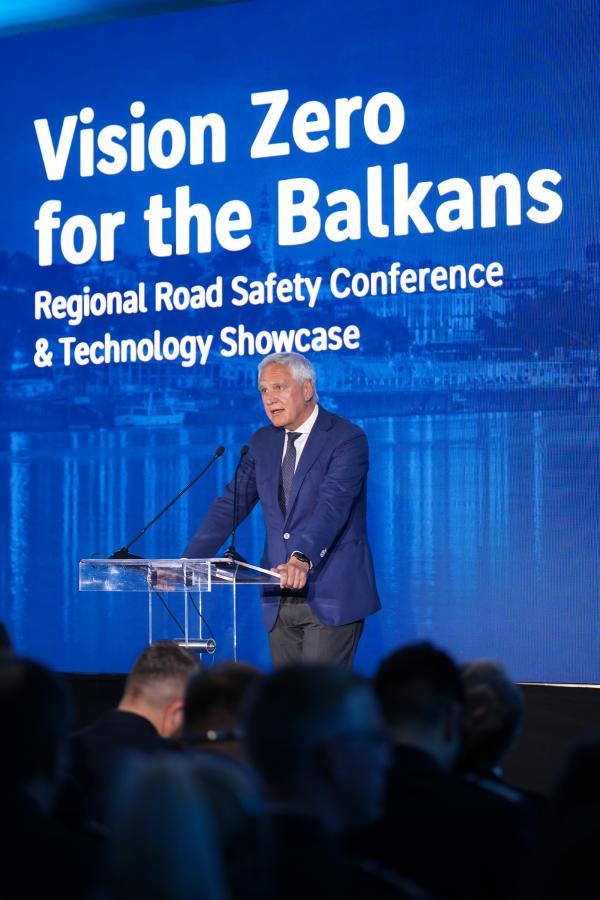How Serbia’s roads are getting a safety boost with the backing of multilateral development banks, as they improve links around the Western Balkans
As the threat of COVID-19 recedes, another silent epidemic continues to take 1.3 million lives every year and cause 50 million injuries. Road deaths and injuries have been declared a crisis of epidemic proportions by the World Health Organization.
And the Western Balkans continues to record a much higher ratio of road-related deaths and serious injuries than the European Union.

“In 2022, road fatalities claimed almost 1 300 lives in the Western Balkans,” said European Investment Bank Vice-President Kris Peeters during his opening address at the regional road safety conference Vision Zero for the Balkans held in Serbia in May.
“We need to take decisive action to prevent this immense loss of life and economic output,” Peeters said. “Through the European Investment Bank’s Transport Lending Policy, we are committed to prioritising projects and activities that help accelerate the safe and sustainable transport systems of tomorrow.”
Protecting the most vulnerable road users
The conference was organised by the International Road Federation, the Serbian Road Traffic Safety Agency and the Transport Community, as part of the 7th UN Global Road Safety Week which focused attention on delivering a safer road environment for vulnerable road users. According to the World Health Organisation, over half of all road traffic deaths are pedestrians, cyclists and motorcyclists.
At the event, prominent international experts underlined Serbia’s progress in road safety, where the number of fatalities has decreased by 27% between 2011 and 2021. However, the country continues to record a higher proportion of road traffic deaths per 100 000 inhabitants than the EU average (7.5 in Serbia compared to 5.1 in the European Union).
“The road safety system must be upgraded with the most vulnerable in mind, particularly pedestrians, cyclists and motorized two-wheelers,” noted Dmitry Mariyasin, Deputy Executive Secretary of the United Nations Economic Commission for Europe.
“In this regard, we encourage policy makers in Serbia to improve traffic safety in urban areas, introduce stricter speed controls, focus on road defects that can lead to serious and fatal injuries,” Mariyasin said, “and to consider how to use advanced technology for the sake of traffic safety.”
Towards Vision Zero
Seeking to reduce deaths and serious injuries by 50% by 2030, the European Union has adopted a road safety policy for 2021 to 2030, with the further aim of achieving zero road deaths by 2050.
“At the core of Vision Zero is the realization that all road users are sometimes tempted to break a speed limit, become distracted and make mistakes,” said Rob Eenink, president of the Forum of European Road Safety Research Institutes at the conference.
“The traffic system as a whole – our roads, vehicles, signaling systems – should be designed in such a way that road users are not distracted or tempted,” Eenink said, “so that they do not need to deal with complicated situations where it is easy to make a mistake and, when an accident is inevitable, that they are protected from serious injury.”
The Western Balkans Road Summit was jointly organised by the European Investment Bank, whose Vice President Lilyana Pavlova supplied the keynote speech, the Transport Community, and the European Bank for Reconstruction and Development in Tirana in 2022. At the summit, regional ministers in charge of transport committed to adopt the Vision Zero perspective when developing road safety strategies and policies.
Though they have publicly supported the approach, there is still a long road ahead to implementing the necessary strategies, legislation and investments.
In Serbia, high toll of traffic accidents needs to be halved
In 2022, 553 people died in road crashes across Serbia, while 30 000 lives were lost over the last 30 years. This is the size of a small town in the country.
The Serbian Government is undertaking measures to prevent road traffic mortality, with a particular focus on curbing inappropriate speeds and the failure to use a seatbelt, which are the leading causes in Serbia. The country’s new national traffic safety strategy aims to cut deaths by 50% compared to 2019.
“Losses of life, human capital and infrastructure represent a huge cost to communities. Vision zero must become a priority for all of us, which means that no loss of life or serious injury in traffic is acceptable,” said Branko Stamatović, acting director of Serbia’s Traffic Safety Agency.
Road safety built into investment decisions
Following the approval of the European Investment Bank’s new Transport Lending Policy in July 2022, safety has become one of four key pillars of its operations and engagement in the sector. The Bank has partnered with three non-governmental organisations to inform and support investments in safer road projects since 2021, and signed an agreement with the UN Economic Commission for Europe to strengthen collaboration in the field of road safety and climate resilient transport infrastructure in the same year.
Along with building new road networks, the rehabilitation of existing roads to safer and more sustainable standards will require massive investment. In the European Union alone, a European Investment Bank study identified €21 billion in safety investment needed over 10 years to increase the engineering standards of the least-safe roads and save up to 7 200 lives.
The European Investment Bank has a long track record in the sector, with annual investments of around €11.6 billion going to transport. In the Western Balkans, the Bank has supported close to €6 billion of transport investment to date. Financing is often complemented by grants and advisory support for the preparation and implementation of high-quality projects that promote safety, accessibility, and sustainability.

Major financier of transportation projects in the Western Balkans
EIB Global, the dedicated branch of the European Investment Bank for activities outside the European Union is already supporting the rehabilitation of and safety improvements to hundreds of kilometres of the national road network in Serbia, including through major road safety investments.
In 2022, EIB Global signed €666 million of new projects in Serbia, of which €581 million was for sustainable transport, such as waterways and railway routes.
Along with the reconstruction of existing roads, EIB Global is supporting the development of new road sections with the highest safety standards. Currently, the Highway of Peace connecting Serbia with the Adriatic coast of Albania is being built thanks to a €100 million EIB loan and a €40 million EU grant. This flagship project under the Economic and Investment Plan consists of the construction of 32 km of highway to link Niš and Merdare. The new road will facilitate regional cohesion and cut accidents by 16%.
